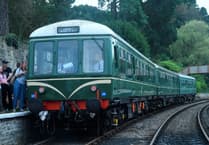There’s a bleak section of the A4136 Monmouth to Gloucester road, as it meets with the A4151 which runs down from Cinderford, the unclassified road that will take you to Drybrook or Harrow Hill (locally known as Harry Hill) or Ruardean. The area is known as Nailbridge, and might be classified as part of Steam Mills, or as a remote suburb of perhaps Cinderford, or Ruardean, or Drybrook, or Harrow Hill. It’s a complex junction, with traffic light controls, where you have to weave your way around a large island to get to the right exit.
But in Forest history this was a busy coal mining area, known as ‘Dunk’s Carner’ (not Dunk’s Corner, as outsiders may spell or pronounce it). The name derives from the landlord of the pub that was the popular social venue for the locals. The Railway Inn was the pub, and the landlord of the pub in the 1890s was Albert Dunkley. So ‘Dunk’s Corner’ became the name for the area, as an abbreviated form of his name became its local name, and stuck with it for many years. The Northern United colliery was close by, with scattered hamlets where miners and their families lived.
The Nailbridge railway station on the track to Drybrook, the Railway Inn, and local hamlets have not survived, and the desolate crossroads at the road junction now mark this formerly residential and industrial area. The Northern United Colliery, the last relic of the area’s heavy industrial history finally closed in 1965.
I have to acknowledge the source of much of this information comes from the delightfully descriptive little local stories in ‘Tales from Dunk’s Carner’, by John Christian, an anthology of brief atmospheric tales of life in the vibrant Forest community that was John’s home in the 1930s. He confesses that the stories may not always be precisely correct, but they are amusing, and they describe a lost world where people worked hard and enjoyed many traditional forms of activities.
The Railway Inn which put Dunk’s name on the map was a jolly pub where you could ‘get a pint or a black eye as easily as the other’. Gloucester Cider was called ‘Stunem’ and it lived up to its name. The main reason for this was that it was casked in old wine or brandy kegs which added to its ‘kick’. Another local cider was called ‘Tanglefoot’ for a similar reason.
John’s stories tell of foresters’ busy lives, which included gardening, brass bands, and church. Their dialect was unintelligible to outsiders. There is one tale in which he had to advise tourists that the wonderful peaceful meadows of bluebells they were enjoying at Cannop were on the site that years previously were scarred by industrial wastelands of railway and coal.
The stories are brief and not necessarily precisely true, but they are true to life, celebrating the rich social lives of remote rural industrial communities which built up their own traditions and used their own dialect that the ‘vurroners’ (foreigners or other outsiders) would never understand.





Comments
This article has no comments yet. Be the first to leave a comment.